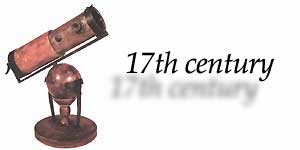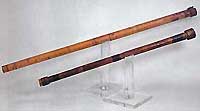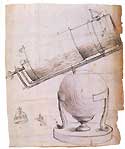
17th-century telescopes
Click on any photo to enlarge it.

 alileo was given credit for the discovery of the telescope
because he was the first to publish his findings in March of 1610. He was not the first to build a telescope (he himself
stated this in his writings) and he was not the first to use it for astronomy. The credit for the discovery is still debated by historians.
But Galileo's writings changed the course of science forever. His colleages at the University of Padua attempted to discredit his
results while also refusing to look through his telescopes. It was the Venetian Senate who was the most impressed. They immediately
saw the military applications of the new "spyglass". The biography of Galileo is as exciting as any modern novel, and the complete details
of his life are worth reading (see the bibliography.) Galileo's telescopes were constructed by
placing a weak concave glass (thicker in the middle) at one end of a paper tube, and a strong convex glass (thinner at the middle)
at the other end. It was so simple to make that the instrument spread like wildfire throughout Europe. Galileo's scopes had magnifying
powers up to 30X. Two of his telescopes are now kept at a museum in Florence, Italy.
alileo was given credit for the discovery of the telescope
because he was the first to publish his findings in March of 1610. He was not the first to build a telescope (he himself
stated this in his writings) and he was not the first to use it for astronomy. The credit for the discovery is still debated by historians.
But Galileo's writings changed the course of science forever. His colleages at the University of Padua attempted to discredit his
results while also refusing to look through his telescopes. It was the Venetian Senate who was the most impressed. They immediately
saw the military applications of the new "spyglass". The biography of Galileo is as exciting as any modern novel, and the complete details
of his life are worth reading (see the bibliography.) Galileo's telescopes were constructed by
placing a weak concave glass (thicker in the middle) at one end of a paper tube, and a strong convex glass (thinner at the middle)
at the other end. It was so simple to make that the instrument spread like wildfire throughout Europe. Galileo's scopes had magnifying
powers up to 30X. Two of his telescopes are now kept at a museum in Florence, Italy.

In the seventeenth-century,
it had been known for some time that a ray of light passing through a prism
produces a series of colors. By Newton's time, it was also well known that water droplets would produce a rainbow
by the same prism effect of each droplet. The problem with refracting telescopes was that the lens acted like a
prism, breaking up white light into its constituent colors. It then focuses each color at a slightly different point along the telescope's axis.
A bright star or planet viewed through a refractor with a single objective lens would have a bright red and violet halo around it. This sort of extreme color aberration
in an objective lens reduces the contrast of the images, blurs the focus, and obscures detail in the image. Eventually,
a way would be found to supress this chromatic aberration by combining two lenses made of different types of glass,
one in front of the other, for the objective lens.
This system, though imperfect, is still in use today
for moderately-priced refracting telescopes. Even modern scopes still show a bit of violet halo around bright objects.
Newton, however, without access to this technology, suggested a completely
different approach: do away with the lenses altogether and use a curved mirror to reflect and focus the white light
(and all of its colors) to a single point. A mirror does not "refract", or bend the light and create a rainbow. Newton
placed a second, flat, smaller mirror in front of the curved mirror to catch the rays of light and reflect them out
the side of the tube to an eyepiece, which would magnify the image. Click on Newton's original drawing and on his
brown wooden scope at the top of this page to see more detail.
The objective lenses of refracting telescopes
at Newton's time were limited to about two inches in diameter. A mirror could be made much larger than this. By the nineteenth century,
mirrors were ocassionally larger than a yard in diameter. A reflecting telescope could be made much shorter and easier to transport than a refractor.
It was discovered that the longer a refractor was made, the closer the individual colors would tend to focus, supressing chromatic aberration.
Refractors sometimes became as long as forty feet! These longer lengths were also necessary to achieve a higher
magnification. In the nineteeth century, reflecting telescopes also produced brighter images than refractors, owing to the larger size of the objective mirror.
By the 21st century, telescope makers had discovered how to make a refractor
focus all the colors of light very, very close to a single point--at least close enough that the human eye can no longer detect the halo of chromatic aberration.
This often requires a triplet--three lenses combined to make an objective. Sometimes two additional corrector lenses are used, making a total of four lenses in
the telescope, not counting the eyepiece. At least one of the lenses must be made from a very rare and expensive
glass, so that these telescopes, called apochromatic, cost about 20 times as much as a telescope with a doublet, or achromatic objective.
Nearly all the refactors made today are achromatic, since only a very few people can afford the "apos." A reflective telescope accomplishes the
same thing for a fraction of the cost. In spite of this, many people still prefer a refracting telescope. The secondary mirror in a reflecting
telescope, placed squarely in the light path, reduces image contrast slightly. A refracting telescope produces superior image contrast and a little
better detail, especially on the planets. The secondary color aberration in modern achromatic telescopes has been reduced by modern computer-configured
optics to a faint purple glow around bright objects. Some observers have no trouble ignoring this, like scratches on an old vinyl record.
Many serious observors today own one of each type of telescope, a refractor and a reflector. We can only suppose that Newton did too!
 alileo was given credit for the discovery of the telescope
because he was the first to publish his findings in March of 1610. He was not the first to build a telescope (he himself
stated this in his writings) and he was not the first to use it for astronomy. The credit for the discovery is still debated by historians.
But Galileo's writings changed the course of science forever. His colleages at the University of Padua attempted to discredit his
results while also refusing to look through his telescopes. It was the Venetian Senate who was the most impressed. They immediately
saw the military applications of the new "spyglass". The biography of Galileo is as exciting as any modern novel, and the complete details
of his life are worth reading (see the bibliography.) Galileo's telescopes were constructed by
placing a weak concave glass (thicker in the middle) at one end of a paper tube, and a strong convex glass (thinner at the middle)
at the other end. It was so simple to make that the instrument spread like wildfire throughout Europe. Galileo's scopes had magnifying
powers up to 30X. Two of his telescopes are now kept at a museum in Florence, Italy.
alileo was given credit for the discovery of the telescope
because he was the first to publish his findings in March of 1610. He was not the first to build a telescope (he himself
stated this in his writings) and he was not the first to use it for astronomy. The credit for the discovery is still debated by historians.
But Galileo's writings changed the course of science forever. His colleages at the University of Padua attempted to discredit his
results while also refusing to look through his telescopes. It was the Venetian Senate who was the most impressed. They immediately
saw the military applications of the new "spyglass". The biography of Galileo is as exciting as any modern novel, and the complete details
of his life are worth reading (see the bibliography.) Galileo's telescopes were constructed by
placing a weak concave glass (thicker in the middle) at one end of a paper tube, and a strong convex glass (thinner at the middle)
at the other end. It was so simple to make that the instrument spread like wildfire throughout Europe. Galileo's scopes had magnifying
powers up to 30X. Two of his telescopes are now kept at a museum in Florence, Italy.

